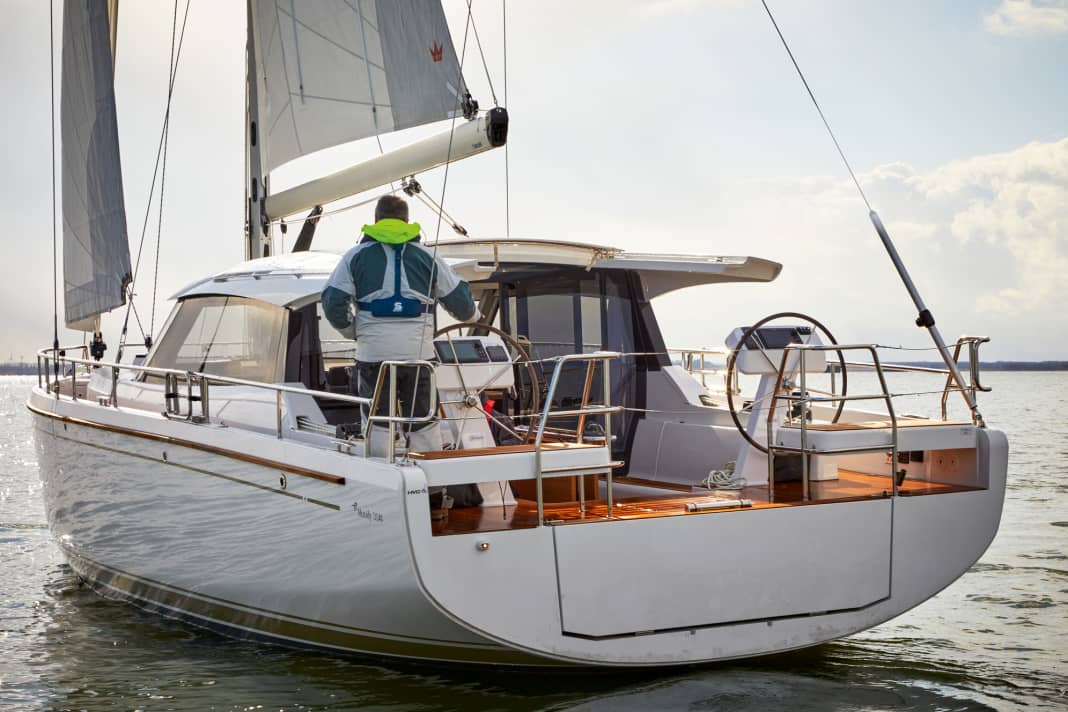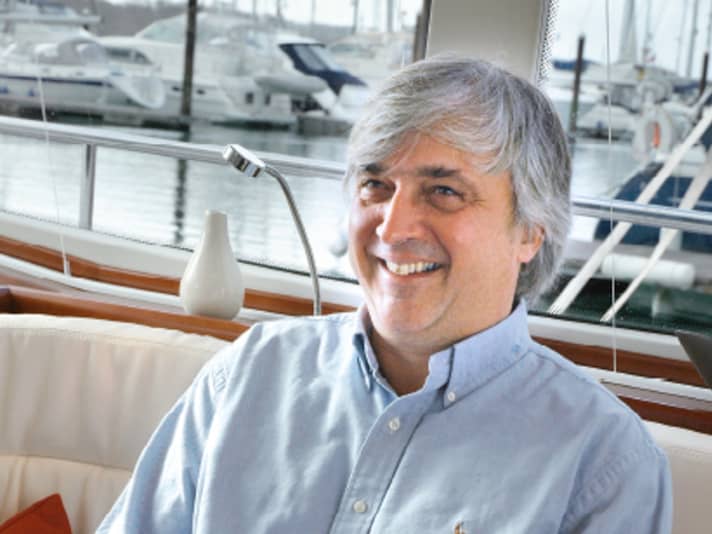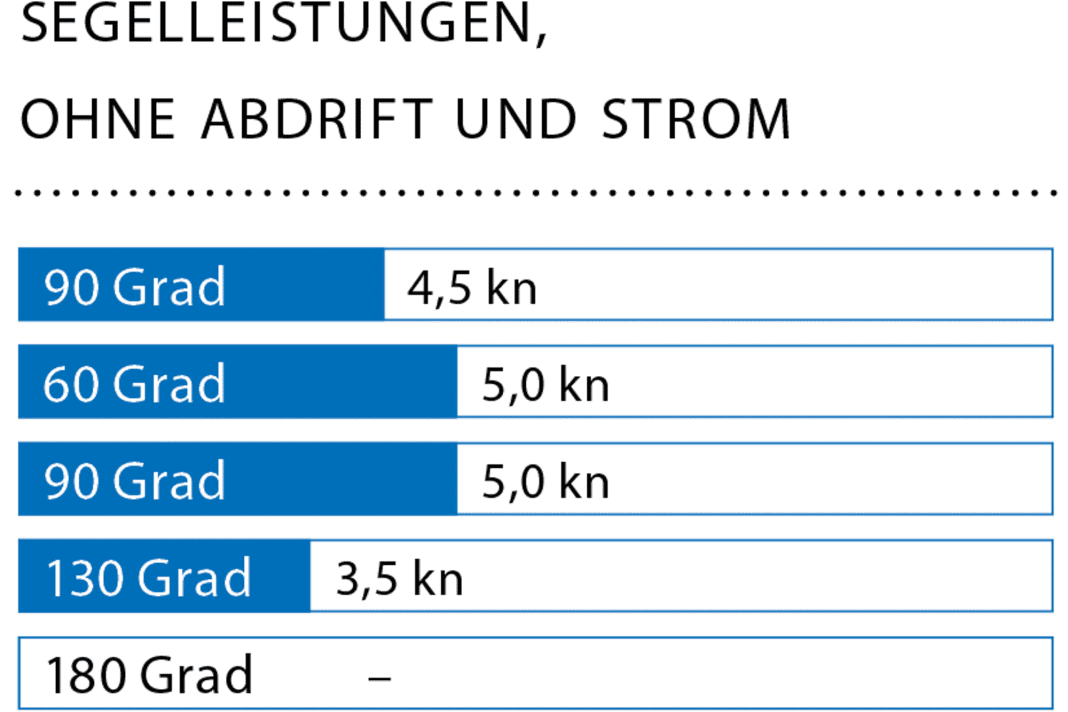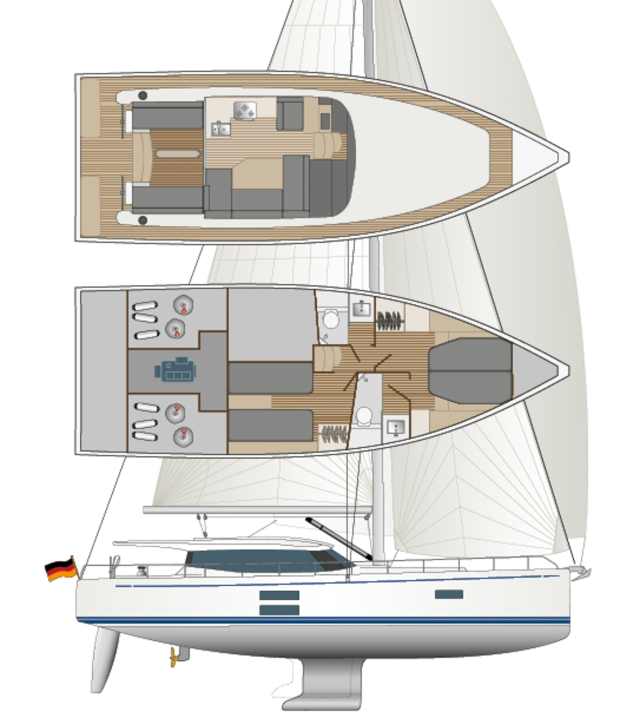





Evil tongues claim that designers print out drawings of their yachts in the copier at a lower zoom level when they are commissioned to produce a smaller model of a successful boat. In reality, however, this does not usually work, because one factor remains - the human being with his typical dimensions, ergonomic requirements, learnt processes; after all, the human being does not shrink with the boat. Consequently, the freeboard on the smaller boat must be higher in relation, the number of cabins less, the space less, the distribution different, a new prioritisation is needed.
Example Moody. Apart from the 41 with aft cockpit, the upmarket line from Hanseyachts AG consists of deck saloon yachts and is characterised by its unique spatial concept. The cockpit, saloon, navigation and galley are all on the same level, just like on a catamaran or motorboat. The helm stations are mounted on deck. Only cabins and storage spaces are located on the lower level. The seating areas and the interior helm stations are on a higher level and the superstructure is glazed all round. This ensures a perfect 360-degree view when seated or standing.
The competition of the Moody DS 41
The highly acclaimed and well-selling Moody DS 45 was the first in-house development following the takeover of the traditional English shipyard by the expanding Hansegroup. The Greifswald-based company, at that time still under the leadership of its founder and, after the IPO, CEO Michael Schmidt, did not take over any designs and moulds, but did take on the long-serving in-house designer Bill Dixon, who has been responsible for the DS line ever since.
The designer, who works near the former Moody shipyard in Southampton, managed to realise the specifications formulated by Schmidt: "Light, visibility and life on one level. That's what people have always wanted."
Tradition meets innovation with the Moody DS 41
Schmidt and Dixon remained committed to the shipyard's history. Moody, founded back in 1830, has always stood for solidly built and well-equipped yachts suitable for blue water. And the latter means, as long-distance sailing icon Bobby Schenk puts it, that the crew spends a lot of time on board, but 80 per cent of it in the harbour. And this is where Moody's concept comes in. The other considerations are also based on the habits of the crew. They will spend two thirds of the day on deck, in the cockpit, in the saloon and galley and only spend the rest of the time in the wet cells and berths. It therefore seems sensible to organise the most frequent routes on one level and make them as comfortable as possible.
Another aspect: life on board during the day on a DS is no longer divided into activities on deck and below deck, but the crew is together for all activities. Those who cook are not in the cellar; those who navigate have visual contact with the helmsman; those who seek shade or protection are in the saloon and are still part of the action. Perfect socialising during the day, ideal separation at night.

"The boat, which is wide all the way aft, allows for a particularly comfortable interior and plenty of space for a 41-footer. The main feature is the living space at ground level. The difference in height from the cockpit to the wheels was also important. And the deckhouse allows maximum all-round visibility"
Bill Dixon, Moody designer and expert for blue water yachts with deckhouse
And: when travelling with a small crew, the saloon sofa can be used as a sea berth if it is equipped with a leeward sail. This way, the free-ranger is quickly on deck and only needs to raise his head briefly to check that everything is in order.
Moody DS 41 benefits from the high-rise effect
This bundle of advantages comes at a price: a deck saloon yacht per se lacks elegance and light-footedness. This is where the high-rise effect comes into play: it doesn't look so great from the outside, but once you're inside and look out, you can enjoy the view. Despite the inevitably high superstructure, Dixon and his internal design partners at Hanseyachts were able to give the Moody DS 41 a very unique aesthetic. The soft chines contribute to this, as do the slightly negative deck step, the concave undersides of the superstructure roof, the bevelled top edge of the freeboard and the wide stem. It fits, absolutely.
Surprisingly, the 41, like its larger sisters, has a half-height bulwark that visually increases the freeboard, yet the ship does not appear clumsy. The shipyard has eliminated the further disadvantage of poor accessibility when lying alongside the jetty: A segment of the fixed railing can be folded down and then serves as a stepladder.
Another special feature: you don't have to climb out of the cockpit over coamings, but walk forwards from the wheel on one level. The narrow but still easily accessible deck rises by around seven centimetres, which is barely visible. This so-called walkaround cockpit is somewhat comparable with those of the otherwise conventional Jeanneau Sun Odyssey 410 and 440 models.
Self-tacking with genoa option
It's clear that the Moody DS 41 is completely different, both visually and conceptually. And it has to live with the prejudice that deck saloon yachts sail worse because they are heavier and have a higher centre of gravity.
On paper, she is indeed heavier than her direct competitors and has a slightly smaller sail carrying capacity. This is also due to the fact that the standard sail is designed as a self-tacking jib - which fits in perfectly with the concept of a comfortable long-distance cruiser for a small crew. In addition to a gennaker or code zero as a speed booster, a second furling headsail can also be used, which is permanently furled on a separate stay in front of the jib. The 135 per cent genoa measures 54.4 square metres. This gives the ship a sail carrying capacity of 4.5 metres, which makes it much more sporty. The furling system with stays and genoa rails is available for an extra charge, electrified for even more. The sail itself comes on deck in its simplest version from in-house supplier Elvstrøm, also for an extra charge.
A sail that would have done the boat good for the test. Because although the conditions varied between hail showers and sunshine, the wind was constantly light. However, the hard rain was easy to deal with on a trial basis: into the cabin, autopilot on. The boat can also be manoeuvred under engine power using the optional control lever in the navigation corner. The all-round visibility is excellent and is only interrupted by a few supporting pillars.
Unfortunately little wind during the test
But even standing at the two wheels, the view to the front is not greatly disturbed. Blind spots can be eliminated simply by looking through the house. Two helmsman's seats provide comfort and, measuring 0.52 by 1.14 metres, offer enough space for two. The boat steers beautifully directly, one and a quarter turns from stop to stop are sufficient. The excellent system from Danish manufacturer Jefa with two redundant gearboxes also works beautifully without slippage.
Unfortunately, at 5 to 8 knots, the wind is too light for the DS 41, although it does move, and the figures are fine given the circumstances and the concept, which also applies to the turning angle of 90 degrees. But like many boats with a self-tacking jib, this boat also needs around 10 knots to work well.
The halyards, sheets and outhaul are led aft through the superstructure. The mainsheet is attached to the roof as a German cupper system and is run on both sides, a nice solution. The winches are mounted in front of the wheels so that they can be operated by the helmsman as well as from the cockpit. The friction caused by the installation of the lines is limited, but noticeable. The size 45 Lewmar electric winches supplied as standard make up for this. In this context, however, the AGM battery pack does not appear to be ample; it provides 320 ampere hours for the service area, which may be sufficient for normal consumers, but means recharging quite quickly if the electric winches are used extensively.
All-round protection in the cockpit on the Moody DS 41
Ease of use is also an issue with the rigging: conventional Seldén products are used as standard. A furling mast from the same manufacturer, which can also be operated electrically, is offered as an option.
The crew sits protected by high coamings in the cockpit, which is around 40 centimetres lower than the deck, which is easily reached via a step. They are supported by the fixed cockpit table with two folding surfaces. The thwarts are 1.70 metres long, enough for stretching out, but not enough for lying down. The superstructure roof is partially extended to form a fixed bimini. The gap in between can be closed or opened using a textile cover reinforced with rods. The rain and sun protection is included as standard. All that's missing are three side panels and the cake shack is perfect, almost doubling the daytime living space even in bad weather.
A 2.40 metre wide and 60 centimetre deep folding bathing platform, which floats just under 30 centimetres above the water when in use, is installed for good use. A telescopic bathing ladder is included as standard, which is easy to use with fold-out handles. An even more comfortable bathing ladder can be ordered as an option.
One third baking box
Perhaps a little sunbathing at the anchorage after a tour around the boat? On the foredeck, cushions can be put together to form a sumptuous sun lounger and a small sofa. These large pieces of foam usually come with a problem: where to put them? A cabin is quickly filled and can no longer be used in any other way. Not so on the Moody, one third of which consists of forecastle boxes, so to speak; there is no living space aft of the superstructure bulkhead. The stowage facilities are located under the cockpit thwarts, can be accessed via large hatches and can be crawled into. Another, almost bizarre-looking space is the cellar under the saloon floor. This can also be crawled into and accommodates the washing machine or a second refrigerator.
The deck saloon is accessed via a large sliding door built into the glass superstructure bulkhead. The room itself impresses with the aforementioned good all-round visibility, the ergonomic dimensions, the space available and the navigation corner at the front of the windscreen, where there is enough room for equipment, a control lever and an autopilot control. The galley is installed lengthways and is large enough, at least for the smaller crew typical on this boat. In addition to the large sliding door, air enters the saloon through a skylight and a hinged window in the superstructure bulkhead. For an extra charge, there are side opening options - but unfortunately none towards the front as on many cats.
The flip side of a good view is a good view. Who wants to sit on a plate with perfect lighting? Curtains and pleated blinds can help, but come at a hefty extra cost. A lot of window space also means a lot of heat in the saloon. Moody counters this with external sun protection materials, which are also often used on twin-hull boats.
The Moody 41 DS offers an airy interior
A third of a forecastle, a sail stowage space at the front, a deck saloon, little real freeboard in view of the high bulwark mean a small, scarce remaining interior space in the basement? Far from it.
There are three steps down about 70 centimetres. There is a centre cabin to the right, with a choice of a double berth or two single berths (extra), but both are quite flat at 40 centimetres above the floor. There is also plenty of standing space and a very large cupboard, sensibly partitioned and automatically illuminated. Two hull windows provide light and a view. The only ventilation option apart from the door is a small hinged window that opens towards the saloon. Opposite the centre cabin there is even more space for fittings. Or the optional guest bathroom can be installed there.
The owner's cabin is located in the foredeck, and it is to be called princely, even if the raised berth only measures 1.42 metres at shoulder height. Hull and opening superstructure windows, hatches and a windscreen fulfil every wish in this discipline. Cupboard and storage space, shelves and space are adequate. The indirect and spot lighting is also dimmable and programmable.
Impressive boatbuilding quality
The large bathroom in the foredeck is exclusively accessible via the owner's cabin. The shower and toilet can be separated from the washroom using Plexiglas. A hatch and a window provide fresh and exhaust air. And with a headroom of 1.93 metres and plenty of legroom, the bathroom is as comfortable as the entire ship. Another nice feature: large toilets are installed and all hull openings are made of durable plastic, a choice that is preferable to brass solutions due to their greater durability.
In general, the installations are very clean and easily accessible. The visible boatbuilding quality is also impressive, including the furniture. Joints, joints, angles - everything fits together and there are no conspicuous or heterogeneous gaps.
Conventional semi-gloss lacquered mahogany surfaces are used for the furniture as standard. Otherwise, the same high-gloss wood, oak in both lacquer variants or teak are possible. For the floor, the owner chooses between light acacia or darker oak; and he has to decide between a black, grey or white worktop and light, cappuccino-coloured or dark fronts in the galley.
Unique rating
A future owner will ask himself many other questions, right down to such subtleties. For example, the alternatives. Once he has decided in favour of a real deck saloon boat with a raised seating area, the only remaining competitors are the more expensive brands Sirius and Nordship and the cheaper models from Wauquiez or the Regina 40 from Sweden.
The Moody DS 41 starts from €624,631. The boat pursues its unique space and deck concept so consistently that it is not really exposed to any direct competition. And a shipyard has to manage that first.
The measured values for testing the Moody DS 41





The Moody DS 41 in detail

Technical data of the Moody DS 41
- DesignerBill Dixon
- CE design category A
- Hull length11.99 m
- Total length12.52 m
- Waterline length11.42 m
- Width 4.20 m
- Draught/alternative2.14/1.83 m
- Theor. hull speed 8.21 kn
- Weight11.2 tonnes
- Ballast/proportion3.13 t/28 %
- Mast height above waterline 19.92 m
- Mainsail45.0 m2
- Self-tacking jib 38.0 m2
- Engine (Yanmar) 42 kW/57 hp
- Fuel tank (plastic)210 litres
- Fresh water tank (plastic) 220/180 litres
- Holding tank (plastic) 54 litres each
Hull and deck construction
Sandwich laminate in hand lay-up process, balsa wood as core material. Iso-gelcoat and vinyl ester resin in first layer. Bulkheads and deck laminated
Equipment and prices
- Base price ex shipyard: € 624,631 incl. 19 % VAT
- Warranty: 2 years
- Standard equipment included: engine, sheets, railing, position lanterns, battery, compass, cushions, galley/cooker, bilge pump, toilet, sailcloth, anchor/chain, fenders, electric cooler, holding tank with suction system
Also included in the price:
- Teak deck, bow thruster, electric winches, side ladders, second water tank, mast steps, helmsman's seats
As of 09/2023, how the prices shown are defined can be found here !
Shipyard
Hanseyachts AG, Ladebower Chausee 11, 17493 Greifswald, phone 03834/5792-200; www.hanseyachtsag.com
Distribution
Dealer network
YACHT rating of the Moody DS 41
The smallest Moody offers plenty of comfort both underway and in the harbour and still fulfils sailing requirements. It is also suitable for use all year round, offers plenty of storage space, is neatly built and equipped to a high standard, even in the standard version
Design and concept
- + Unique layout
- + Well protected cockpit
- + Lots of storage space
- + Deck very safe to walk on
Sailing performance and trim
- + Reasonable potential
- + Suitable for one hand
Living and finishing quality
- + Spacious cabins
- + Sensible room distribution
- - Poorly ventilated centre cabin
- - Forward berth quite narrow
Equipment and technology
- + High-quality equipment
- + Inside steering position feasible
This article first appeared in YACHT 11/2020 and has been updated for this online version.

